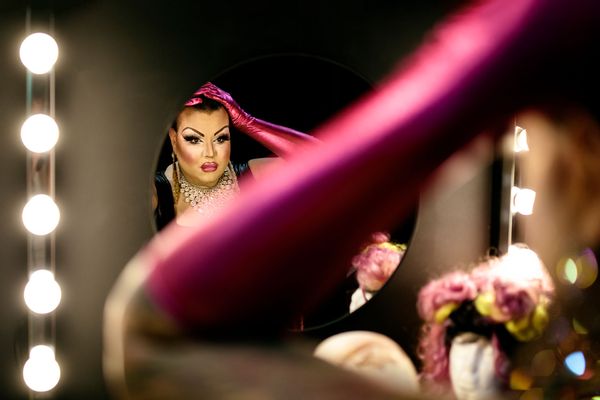
Journalist, editor and author Zahra Hankir wants to make it clear that eyeliner isn’t just about women and beautification. Eyeliner “transcends borders and eras,” she writes in a November essay for The Guardian. But it also challenges our understanding of gender and identity, especially as more men are now incorporating eye makeup into their everyday look.
On TikTok, Gen Z influencers are at the forefront of a new trend centered on countering toxic masculinity, in which 20-something-year-old men partake in fashion and beauty fads that have historically been considered feminine. That includes wearing more ruffles, notably in tops, undershirts or formal wear. That includes wearing body-con silhouettes, like skin-tight flared trousers. And that includes putting on eyeliner. Videos of conventionally attractive men meticulously applying eyeliner to their water lines have already garnered their own category on TikTok: “Men Eyeliner.” These same men caption their content with proud declarations like, “real men wear eyeliner” and “proof all guys should wear eyeliner,” much to the amusement of their fans.
Despite the message that social media is sending, men wearing eyeliner isn't new; they've been using the cosmetic since its earliest inception, Hankir explains in her new book “Eyeliner: A Cultural History.” That’s because eyeliner first emerged as a symbol of culture — not as a beautifier exclusively reserved for women. Take for example ithmid, which is deemed the “purest form of kohl” by Muslims across the Middle East and North Africa and other parts of Africa and Asia. Today, many devout Muslims, namely men, wear ithmid on their eyes because the Prophet Muhammad was said to have worn it. The same goes for surma, another rendition of kohl that’s commonly worn by Muslim men in South Asian countries.
“When Muslim men wear eyeliner as a form of connecting or adhering to the Sunnah, they're not wearing it to beautify themselves. They're wearing it for other reasons,” Hankir explains during a recent conversation with Salon. “The same for the Bedouin community, whereby the men who I spoke to were wearing it to protect against the glare of the sun. So they're not considering it a form of beautifying themselves.”
Years later, eyeliner grew popular with Western men for its aesthetic benefits, thanks to several rock stars who blurred the lines between gender, sexuality and self-expression. Called “guyliner,” the phrase describes the thick, smudged black eyeliner rimming the eyes of some of the biggest sex symbols of the 20th century. David Bowie, Mick Jagger, Keith Richards, Steven Tyler, Prince, Freddie Mercury and more were just a few major names who stenciled their eyes as part of their signature look.
“I think ‘guyliner’ plays a significant role in the idea of sort of mutating into new personas or different personas or . . . rebelling against societal norms,” Hankir says. “How’s the man expected to present? Is he expected to present in this particular way? It’s this idea of playing with gender norms and gender expectations.”
The weight of eyeliner among drag queens

On the other hand, high-profile straight men (or men who were believed to be straight outside of their offstage persona), could dress and look however they pleased without facing any discrimination. It’s why Freddie Mercury could dress up as a vacuuming housewife in his 1984 music video for “I Want to Break Free,” Hankir says. Or Boy George could wear “bold and colorful guyliner.” Or David Bowie could wear “high heels and smoky eyes.” Or Kurt Cobain could wear smudged eyeliner and dresses while performing live.
That being said, Hankir stresses the fact “that eyeliner is deeply personal.” It’s something she learned through her personal story with the makeup tool and the stories of those within the drag community. She recalls the time she saw New York City-based drag queen Lucia Fuchsia perform at a coffee shop in Crown Heights:
“That, to me, really demonstrated the transformative power of eyeliner and how it can give you not just a different aesthetic, but also can give you confidence within your own community when you're looking for a space within it,” Hankir says. “For [Fuchsia], eyeliner is a tangible object that allows him to kind of revel in his queerness, and that's something that I loved to see.”
As for eyeliner’s gender-bending history, Hankir adds that it’s time people understand the many meanings eyeliner can carry: “It is about conveying multiple messages, whether that's about our sexuality, gender, spirituality, heritage or ancestry. That's how deep eyeliner is.”
She continues, “When I think about eyeliner, I don't think about it anymore as a beauty product that is used primarily by women. I think of it as an item that, like ink, can convey so many messages to people who observe the wearer but also, the wearer themselves.
“They're deciding, they're being intentional with the message they want to convey.”







